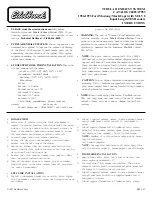
ROOTES MAN UAL WSM. 124
Section N (Elec. Equipment)
6th re-issue
Page 31
DIRECTION INDICATOR SIGNALS
AND HEADLAMP FLASHER
Direction Indicators
The correct operation of direction signals requires
that the bright filament In the parking and tail
lamp bulbs (depending on the position of the switch)
flash Intermittently whether or not the headlamps,
parking lamps, tail lamps or stop lamps are "on".
A correctly operating direction signal will be
Indicated by a regular intermittent flashing of the
green pilot lamp located on facia panel In front of
the driver. If, when the direction indicator is
switched on, the warning (or pilot) lamp does not
flash In the usual manner but remains unlit, first
check that this is not due to filament failure in
either the front or rear lamp on that side. This can
be checked by turning the switch to the opposite
side-if the pilot lamp now flashes, the circuit Is
in order and bulb replacement is indicated. On the
other hand, if the pilot lamp still does not flash,
inspect the indicator lamps. If these are working
normally, failure of the pilot lamp bulb Is indicated.
If, however, the indicator lamps.are not functioning,
It will be necessary to proceed to check the wiring
and flasher unit.
The efficiency of the flasher unit can be readily
checked by plugging in a known substitute.
The inoperative parking or rear flasher lamp bulbs
should be checked for a burned-out bright filament.
Where it is found that neither lamp has a burned
out filament the wiring between the defective
lamp and indicator switch must be checked.
If the direction signal is entirely Inoperative, check
the fuse
(AA
on fuse box), flasher unit and circuit
from the fuse box up through the steering column
switch in the order named.
The flasher unit is located inside the car and Is
plugged into a socket on the underside of the facla.
No servicing of the flasher is required, and where
this unit breaks down in service it must be
renewed.
It is important to note that the twin filament bulbs
used in the side and tail lamps (Lucas 380 12 v.
21/6w.) are the same type. These bulbs have offset
pins and cannot be fitted incorrectly.
Operation of Flasher Unit (See Fig. 31)
This unit depends for Its operation on an electro
magnet in conjunction with the linear expansion of
a piece of wire which becomes heated as current
flows through it.
The expanding and contracting of the wire controls
the speed at which the armature carrying the moving
contact will move, as a result of the pull exerted by
the electro-magnet and the sequence of operations
is as follows:-
As current flows from terminal "B" to terminal
"L" and the lamps via the resistance wire and
electro-magnet, the wire heats up and expands.
This allows the armature carrying one of the con
tacts to be attracted to the pole piece of the
electro-magnet closing contacts (A) and full voltage
is then applied to the lamps via the windings of the
electro-magnet. Contacts (B) are also closed com
pleting the pilot lamp circuit.
CONTROL
WIRE
Fig. 31.
Showing internal
connections of
flasher unit
While contacts (A) are closed the resistance wire
is· short circuited and cools off. The taut section of
the resistance wire contracts and pulls back the
armature to open contacts (A).
The pilot lamp on the facia panel will not flash unless
sufficient current to light the bright filaments
In side (parking) lamp and rear flasher lamp
Is passing through the windings of the electro
magnet to close contacts (B). The flashing pilot lamp,
Summary of Contents for ALPINE I SERIES: APLINE II SERIES
Page 1: ......
Page 189: ...Fis 21 Ball pin heirht checkinr fixture in position Details of items 1 to 4 In Fig 22...
Page 208: ...Fla 3 Exploded view of rear axle Hypoid Bevel Drive...
Page 220: ...Page 16 WSM 12 f Section G Rear Axle 0 QQ I I I I I t 0 ii 8 ts t 0 Cl 2 i J...
Page 247: ...Page6 WSM 124 Section J Steering N Iii it...
Page 299: ...Page 40 3 6 7 8 Fis 22 Se rvo unit exploded view Sect WSM 124 ion K Brakes 18 419 GZo 21...
Page 413: ..._ PRINTED IN ENGLAND 9Y WREN PRINTING CQ LTD LONDON...
















































